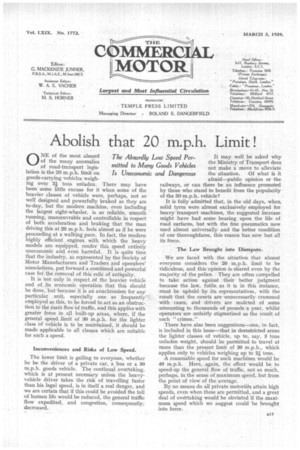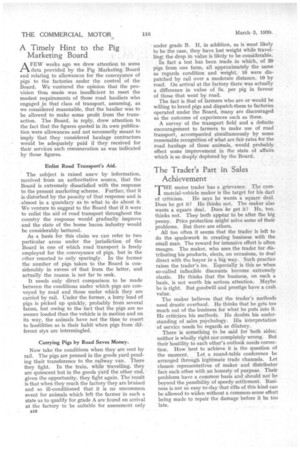Abolish that 20 m.p.h. Limit!
Page 27

Page 28

If you've noticed an error in this article please click here to report it so we can fix it.
0 NE of the most absurd of the many anomalies of road-transport legislation is the 20 m.p.h. limit on goods-carrying vehicles weighing over 2 tons unladen. There may have been some little excuse for it when some of the heavier classes of vehicle were, perhaps, not so well designed and powerfully braked as they are to-day, but the modern machine, even including the largest eight-wheeler, is so reliable, smooth running, manceuvrable and controllable in respect of both acceleration and braking that the man driving this at 20 m.p.h. feels almost as if he were proceeding at a walking pace. In fact, the modern highly efficient engines with which the heavy models are equipped, render this speed entirely uneconomic and even harmful. It is quite time that the industry, as represented by the Society of Motor Manufacturers and Traders and operators' associations, put forward a combined and powerful case for the removal of this relic of antiquity.
It is not only in respect of the heavier vehicle and of its economic operation that this should be done, but because it is an anachronism for any particular unit, especially one so "frequently employed as this, to be forced to act as an obstruction to the main flow of traffic, and this applies with greater force in all built-up areas, where, if the general speed limit of 30 m.p.h. for the lighter class of vehicle is to be maintained, it should be made applicable to all classes which are suitable for such a speed.
Inconveniences and Risks of Low Speed.
The lower limit is galling to everyone, whether he be the driver of a private car, a bus or a 30 m.p.h. goods vehicle. The continual overtaking, which is at present necessary unless the heavyvehicle driver takes the risk of travelling faster than his legal speed, is in itself a real danger, and we are certain that if this could be avoided the toll of human life would be reduced, the general traffic flow expedited, and congestion, consequently, decreased. It may well be asked why the Ministry of Transport does not make a move to alleviate the situation. Of what is it afraid—public opinion or the railways, or can there be an influence promoted by those who stand to benefit from the popularity of the 30 m.p.h. vehicle?
It is fully admitted that, in the old days, when solid tyres were almost exclusively employed for heavy transport machines, the suggested increase might have had some bearing upon the life of road surfaces, but with the fine pneumatics now used almost universally and the better condition of our thoroughfares, this reason has now lost all its force.
The Law Brought into Disrepute.
We are faced with the situation that almost everyone considers the 20 m.p.h. limit to be ridiculous, and this opinion is shared even by the majority of the police. They are often compelled to take action against their better judgment because the law, futile as it is in this instance, must be upheld by -its representatives, with the result that the courts are unnecessarily crammed with cases, and drivers are mulcted of sums amounting to thousands of pounds a year, whilst operators are unfairly stigmatized as the result of such " crimes."
There have also been suggestions—one, in fact, is included in this issue—that in derestricted areas the lighter classes of vehicle, up to, say, 3 tons unladen weight, should be permitted to travel at more than the present limit of 30 m.p.h., which applies only to vehicles weighing up to 21 tons. A reasonable speed for such machines would be 40 m.p.h. Here, again, the effect would be to speed-up the general flow of traffic, not so much, perhaps, in the sense of maximum speed, but from the point of view of the average. By no means do all private motoriSts attain high speeds, even when these are permitted, and a great deal of overtaking would be obviated if the maximum speed which we suggest could be brought into force.
A Timely Hint to the Pig Marketing Board
AFEW weeks ago we drew attention to some data provided by the Pig Marketing Board and relating to allowances for the conveyance of pigs to the factories under the control of the Board. We ventured the opinion that the provision thus made was insufficient to meet the modest requirements of those road hauliers who engaged in that class of transport, assuming, as we considered reasonable, that the haulier was to be allowed to make some profit from the transaction. The Board, in reply. drew attention to the fact that the figures quoted in its own publication were allowances and not necessarily meant to imply That they considered haulage contractors would be adequately paid if they received for their services such remuneration as was indicated by those figures.
Enlist Road Transport's Aid.
The subject is raised anew by information, received from an authoritative source, that the Board is extremely dissatisfied with the response to the present marketing scheme. Further, that it is disturbed by the paucity of that response and is almost in a quandary as to what to do about it. We venture to suggest to the Board that if it were to enlist the aid of road transport throughout the country the response would gradually improve and the state of the home bacon industry would be considerably bettered.
As a basis for this claim we can refer to two particular areas under the jurisdiction of the Board in one of which road transport is freely employed for the conveyance of pigs, but in the other resorted to only sparingly. In the former the number of pigs taken to the Board is considerably in excess of that from the latter, and actually the reason is not far to seek.
It needs only direct comparison to be made between the conditions under which pigs are conveyed by road and those under which they are carried by rail. Under the former, a lorry load of pigs is picked up quickly, probably from several farms, but owing to the fact that the pigs are no sooner loaded than the vehicle is in motion and on its way, the animals have not the time to resort to hostilities as is their habit when pigs from different stys are intermingled.
Carrying Pigs by Road Saves Money.
Now take the conditions when they are sent by rail. The pigs are penned in the goods yard pending their transference to the railway van. There they fight. In the train, while travelling, they are quiescent but in the goods yard the other end, given the opportunity, they fight again. The result is that when they reach the factory they are bruised and so ill-conditioned that it is no uncommon event for animals which left the farmer in such a state as to qualify for grade A are found on arrival at the factory to be suitable for assessment only els under grade B. If, in addition, as is most likely to be the case, they have lost weight while travelling-, the drop in value is likely to be considerable.
In fact a test has been made in which, of 20 pigs from one farm, all approximately the same as regards condition and weight, 10 were dispatched by rail over a moderate distance, 10 by road. On arrival at the factory there was actually a difference in value of 5s. per pig in favour of those that went by road.
The fact is that of farmers who are or would be willing to breed pigs and dispatch them to factories operated under the Board, many are discouraged as the outcome of experiences such as these.
A survey of the transport field and a definite encouragement to farmers to make use of road transport, accompanied simultaneously by some reasonable recognition of what are fair rates for the road haulage of these animals, would probably effect some improvement in the state of affairs which is so deeply deplored by the Board.
The Trader's Part in Sales Achievement
THE motor trader has a grievance. The commercial-vehicle maker is the target for his dart of criticism. He says he wants a square deal. Does he get it? He thinks not. The maker also wants a square deal. Does he get it? He, too, thinks not. They both appear to be after the big penny. Price protection might solve some of their problems. But there are others.
All too often it seems that the trader is left to do the spadework in creating business with the small man. The reward for intensive effort is often meagre. The maker, who uses the trader for distributing his products, elects, on occasions, to deal direct with the buyer in a big way. Such practice raises the trader's ire. Especially is this so when so-called inflexible discounts become extremely elastic. He thinks that the business, on such a basis, is not worth his serious attention. Maybe he is right. But goodwill and prestige have a cash value. • The maker believes that the trader's methods need drastic overhaul. He thinks that he gets too much out of the business for what he puts into it. He criticizes his methods_ He doubts his understanding of sales psychology. His interpretation of service needs he regards as dilatory.
• There is something to be said for both sides; neither is wholly right nor completely wrong. But their hostility to each other's outlook needs correction. How best to achieve it is the question of the moment. Let a round-table conference be arranged through legitimate trade channels. Let chosen representatives of maker and distributor face each other with an honesty of purpose. Their problems have a common basis and should not be beyond the possibility of speedy settlement. Business is not so easy to-day that rifts of this kind can be allowed to widen without a common-sense effort being made to repair the damage before it be too late.




















































































